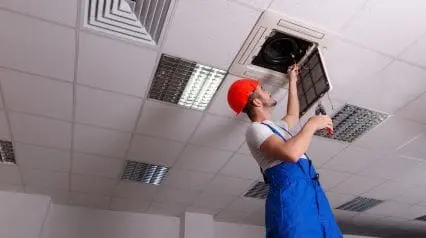How Does a Septic System Work?
Your septic tank is a large underground holding tank where wastewater from the shower, kitchen, laundry, and toilet goes when it leaves your home. The wastewater is treated by bacteria and other microorganisms which break down the waste matter. Afterward, the effluent flows out of the tank into a drain field, percolating back into the ground.
The size of the septic tank is based on the number of bedrooms in a home. A typical tank can hold 1,000 gallons (3,785 L) of water waste; on average, each household member uses 70 gallons of water per day. It’s essential to have the septic tank pumped every 3 to 5 years to remove any solid waste that accumulates on the bottom. If solid waste isn’t removed, it can eventually clog the tank and soil treatment area, causing backups.
Backups occur because the bacteria in the tank have been overwhelmed by too many solids. Backups can be very dangerous, especially if no backup pump is installed.
Types of Septic Systems
There are several types of septic systems. Learn more about them below.
Septic Tank
A septic tank is the most common kind of septic system. It consists of a tank (usually made of concrete, fiberglass, or polyethylene) that receives sewage from your home. The tank stores the sewage to allow solids to settle to the bottom and oil and grease to rise to the top. The tank then releases the treated effluent (liquid waste) into a leach field for further treatment.
Conventional System
A conventional septic system includes a leach field and a septic tank. The leach field is a network of trenches or beds filled with gravel or other materials. The septic tank’s water waste goes to the leach field, where bacteria treat it as it percolates through the soil.
Chamber System
A chamber system is similar to a conventional septic system, but the leach field consists of prefabricated concrete chambers instead of trenches. The chambers are stacked on top of each other and arranged linearly.
Drip Distribution System
A drip distribution system is a variation of a conventional leach field. Wastewater from the septic tank is distributed evenly throughout the leach field by perforated pipes. The wastewater then drips through the soil, where bacteria treat it, such as in a conventional septic system.
Aerobic Treatment Unit
An Aerobic Treatment Unit (ATU) is a septic system that uses oxygen to treat sewage. ATUs come in various designs, but most consist of a tank that contains baffles or partitions to separate the solids from the liquids. Bacteria break down the solids while the liquids are pumped out of the tank and, similar to the septic tank system, into a leach field for further treatment.
Mound System
Mound systems are used when the natural soil conditions are unsuitable for a conventional or chamber system. A mound system comprises a septic tank and a leach field built on a mound of compacted soil. The mound provides extra effluent treatment as it flows through the ground.
Recirculating Sand Filter System
A recirculating sand filter system consists of a septic tank, a pump chamber, and a recirculating sand filter. Wastewater from the septic tank is pumped into the pump chamber and then to the sand filter. The wastewater is cleaned as it flows through the sand filter and then returned to the pump chamber. Similar to the ATU and septic tanks system, the treated effluent is then sent to a leach field for further treatment.
Evapotranspiration System
An evapotranspiration system (or ETS) is a septic system that uses evaporation and transpiration to treat sewage. ETSs come in various designs, but most consist of a tank that contains baffles or partitions to separate the solids from the liquids, similar to ATUs. In the tank, effluent is discharged onto a bed of vegetation, where evaporation and transpiration treat it.
Constructed Wetland System
A constructed wetland attempts to replicate the treatment methods in natural wetlands. The septic tank discharges wastewater into the wetland cell, where it passes through the media and is treated by microorganisms, plants, and other media that remove pathogens and nutrients. The wetland cell usually has an impermeable liner, gravel and sand fill, and a layer of vegetation. As with other septic systems, the treated effluent then flows to a leach field for further treatment.
Cluster or Community System
Decentralized wastewater treatment systems collect water from more than one house or building and clean it. It is taken to a site with a treatment and dispersion system close to homes or buildings. These kinds of systems are common in rural neighborhoods.
The Do’s and Don’ts When Maintaining a Septic System
Do’s
Pump it regularly
Pumping helps remove waste from the tank, keeps the tank clean, and prevents sewage backups. Frequent pumping is required if more people use the septic system because of higher water flow.
Regular inspection and maintenance
Perform maintenance and inspection on septic tanks every year to ensure that they are not cracked or leaking. Also, look for any signs of sewage on the ground around the tank.
Create Your Own Routine Maintenance Checklist
Eliminate manual tasks and streamline your operations.
Get started for FREEMaintain a healthy supply of bacteria
Bacteria help break down waste in the septic tank. You can maintain a healthy bacteria population by adding bacteria culture to the tank every 6 months and avoiding using drain cleaners, killing the good bacteria, and damaging the tank itself.
Don’ts
Don’t flush anything else but toilet paper and human waste
Other garbage disposals, such as feminine hygiene products, diapers, facial tissue, cigarette butts, and wipes, can clog the septic tank and cause backups.
Don’t pour grease or oil down the drain
Just like with solid waste products, grease and oil can also clog the septic tank and cause backups.
Don’t plant trees or shrubs near the tank
The roots of trees and shrubs can damage the septic tank and cause leaks.
Don’t park or drive over a septic tank or drain field
The weight of vehicles as well as the roots of trees and shrubs have the same effect; both can damage the septic tank and cause it to leak.
Don’t dig in the area around the tank or the drain field
Digging can damage the tank and the drain field, causing them to leak.
Frequently Asked Questions
You can clean a septic tank naturally by adding enzymes and bacteria to the tank. Enzymes help break down organic matter and bacteria help break down waste matter. Both enzymes and bacteria reduce the amount of solid waste in the tank.
If the septic tank is full, the water waste will not be able to flow out of the tank and into the drain field. It can cause the water level in the tank to rise and overflow through the outlet pipe.
The effluent from the outlet pipe will contain solid waste, which can signify that the septic tank is full. If the tank is full, it is essential to have it pumped out as soon as possible to avoid damage to the system.




